Born: 1525/30, Breugel or Antwerp
Died: 1569, Brussels
Pieter Bruegel the Elder in our online collection
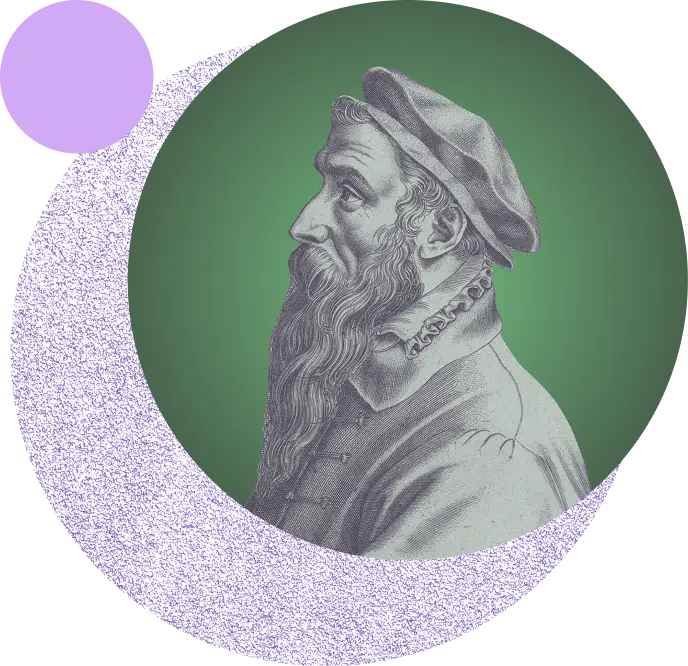
Born: 1525/30, Breugel or Antwerp
Died: 1569, Brussels
Pieter Bruegel the Elder in our online collection
Pieter Bruegel the Elder was probably born in Breugel or Antwerp between 1525 and 1530. He learnt his craft from the Flemish painter Pieter Coecke van Aelst and his wife, the renowned miniature painter Mayken Verhulst. In the beginning, Bruegel was mainly active as a draughtsman and created designs for engravings. Inspired by his role model Hieronymus Bosch, Bruegel also created fantastic, satirical, and moralistic pictorial worlds full of bizarre figures and grotesque scenes, for which he quickly became very popular.
Off to the south! (1552–1554)
At the beginning of the 1550s, Bruegel set off for Italy. His journey initially took him to Rome via France. The journey continued by boat towards Naples and Messina. He then travelled back to Rome, where he worked with his friend Giulio Clovio, a miniature painter. He returned north via the western Alps, presumably also crossing the upper Rhine Valley. Bruegel recorded his impressions on this journey in numerous sketches and drawings, which he would later use in his landscape paintings.
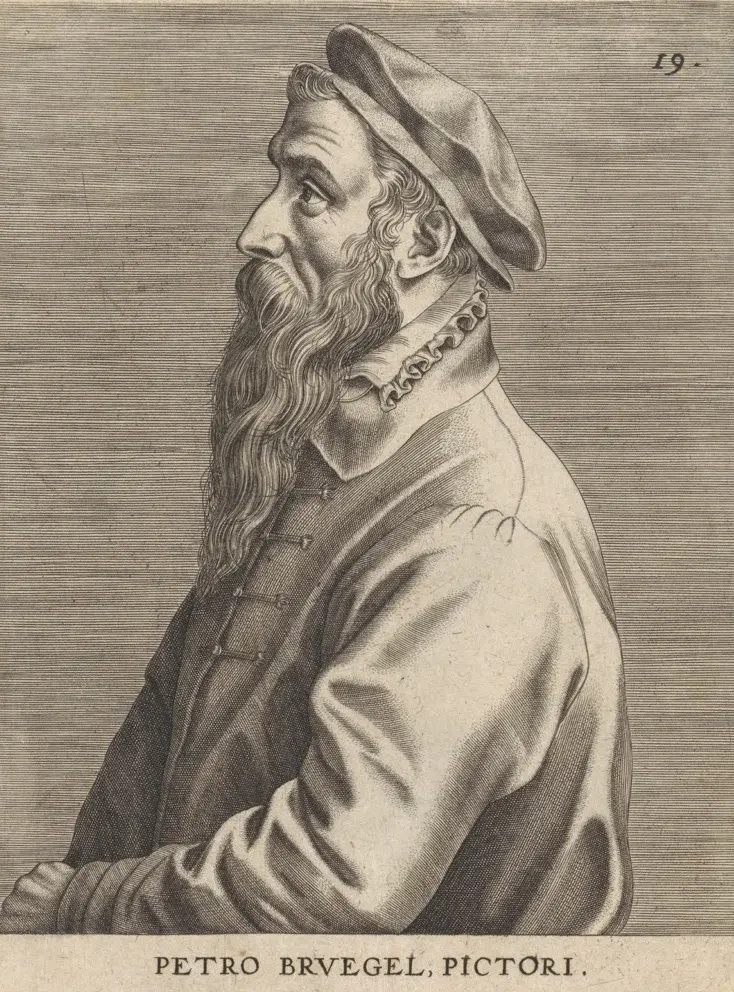
Travel bug – travel blues?
The mere travelling time of the above-mentioned route could take a good year in adverse conditions such as bad weather or accidents, with horse and boat being the main means of transport. Robberies and mudslides also made such journeys an extremely dangerous endeavour. It was best to sign your will before you left!
Today, it would take travellers a good week to complete Bruegel’s route by car, train and boat, while the round trip would probably take two days by plane – excluding rail strikes, flight delays, and car breakdowns!
In good company
He was accompanied on his journey, at least occasionally, by other famous figures such as the cartographer Abraham Ortelius and the sculptor Jacques Jonghelinck. His brother Nicolaes later became one of Bruegel’s greatest patrons, who also commissioned the famous Seasons.
Back to the Netherlands (1554–1563)
After his return from Italy, Bruegel settled in Antwerp in 1554.
At the time, the city was one of the largest trading metropolises and one of the leading art centres in Europe.
Here Bruegel worked with the publisher Hieronymus Cock. Inspired by the impressions of his journey through the Alps, Bruegel created large-format landscape drawings, which were soon published as engravings by Cock. The landscapes enjoyed great popularity among Bruegel’s contemporaries, especially humanistically educated citizens who were very interested in depictions of nature. Bruegel gradually focused more and more on painting. From 1557, he created his first panel pictures, followed shortly thereafter by Children’s Games or The Fight between Carnival and Lent.
At the peak of his career: Brussels
Bruegel moved to Brussels and married the daughter of his teachers Mayken Verhulst and Pieter Coecke van Aelst there in 1563. During this time, he created his most famous masterpieces, such as the Seasons, The Tower of Babel, and the Peasant Wedding, which are also on display at the Kunsthistorisches Museum. Bruegel incorporated his precise observations of nature into his paintings.
In both Brussels and Antwerp, Bruegel worked for influential patrons, including the aforementioned Nicolaes Jonghelinck. In addition, he had contacts in humanist circles, which explains why his works often contain profound allusions to socially relevant topics.
Bruegel continued
Bruegel died in 1569 at the age of about 40. According to one anecdote, on his deathbed he told his wife to burn some of his works so that they would not fall into the wrong hands. This account is a reference to Bruegel’s more socially critical works.
Pieter Bruegel the Elder became the founder of a successful dynasty of painters. Even though his sons were only five and one year old at the time of his death, they followed in their father’s footsteps. His elder son Pieter Brueghel the Younger made a name for himself as his father’s copyist, while his younger son Jan Brueghel the Elder became famous not least for his detailed still lifes.
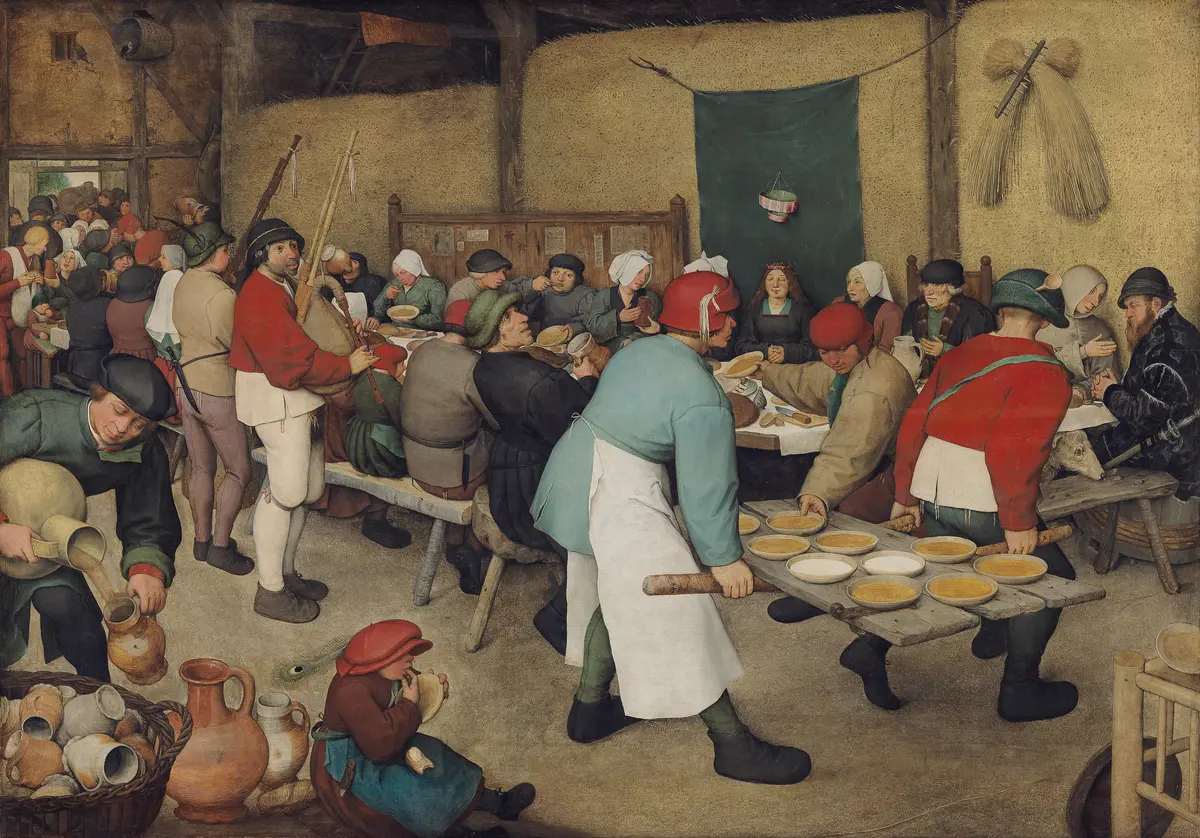
Die scheinbare "Momentaufnahme" ist sorgfältig komponiert. Ohne allegorische Bedeutung schildert das Bild realitätsgetreu eine flämische Bauernhochzeit. Vor dem grünen Behang sitzt die Braut, über ihr hängt eine Papierkrone. Der Bräutigam war nach flämischer Sitte bei der Hochzeitstafel nicht anwesend. Ein Notar mit Barett, ein Franziskanermönch und der Gutsherr mit Hund (ganz rechts) sind erkennbar; die auf einer ausgehängten Tür hereingetragenen Breispeisen sind denkbar einfach, ebenso einprägsam Haltung und Schreitmotiv der Träger.
Title:
Peasant Wedding
Artist:
Pieter Bruegel d. Ä. (um 1525/30 Breugel oder Antwerpen? - 1569 Brüssel)
Time:
1568
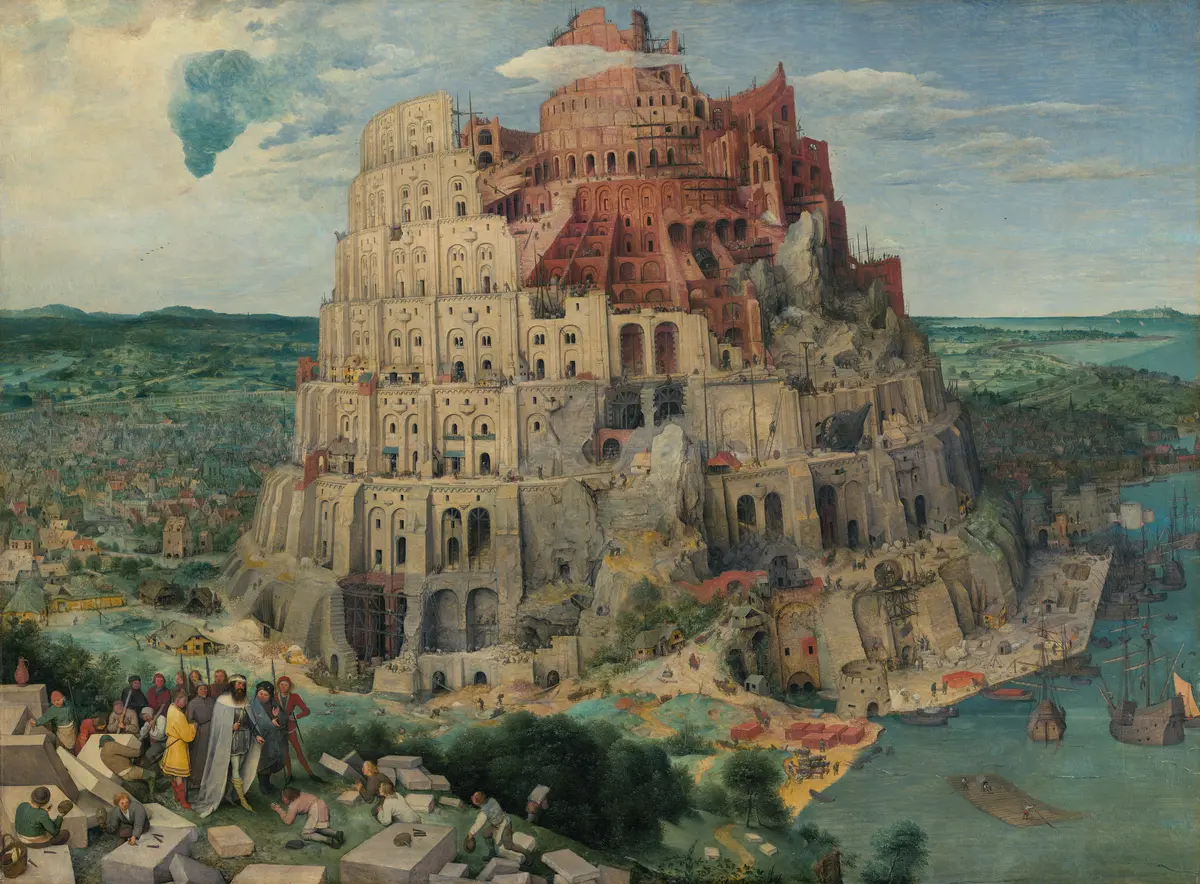
Bruegels monumentale Komposition wurde zum berühmtesten, mannigfach kopierten und variierten Klassiker der Turmbaudarstellungen. Die im Vergleich zum Turm beeindruckend winzige, flämisch anmutende Bebauung der Hafenstadt liefert den Größenmaßstab. Mit Akribie und enzyklopädischem Interesse schildert Bruegel eine Unmenge bautechnischer und handwerklicher Vorgänge. In der steinernen Außenhülle vermischt er antike und romanische Architekturelemente.
Title:
The Tower of Babel
Artist:
Pieter Bruegel d. Ä. (um 1525/30 Breugel oder Antwerpen? - 1569 Brüssel)
Time:
1563
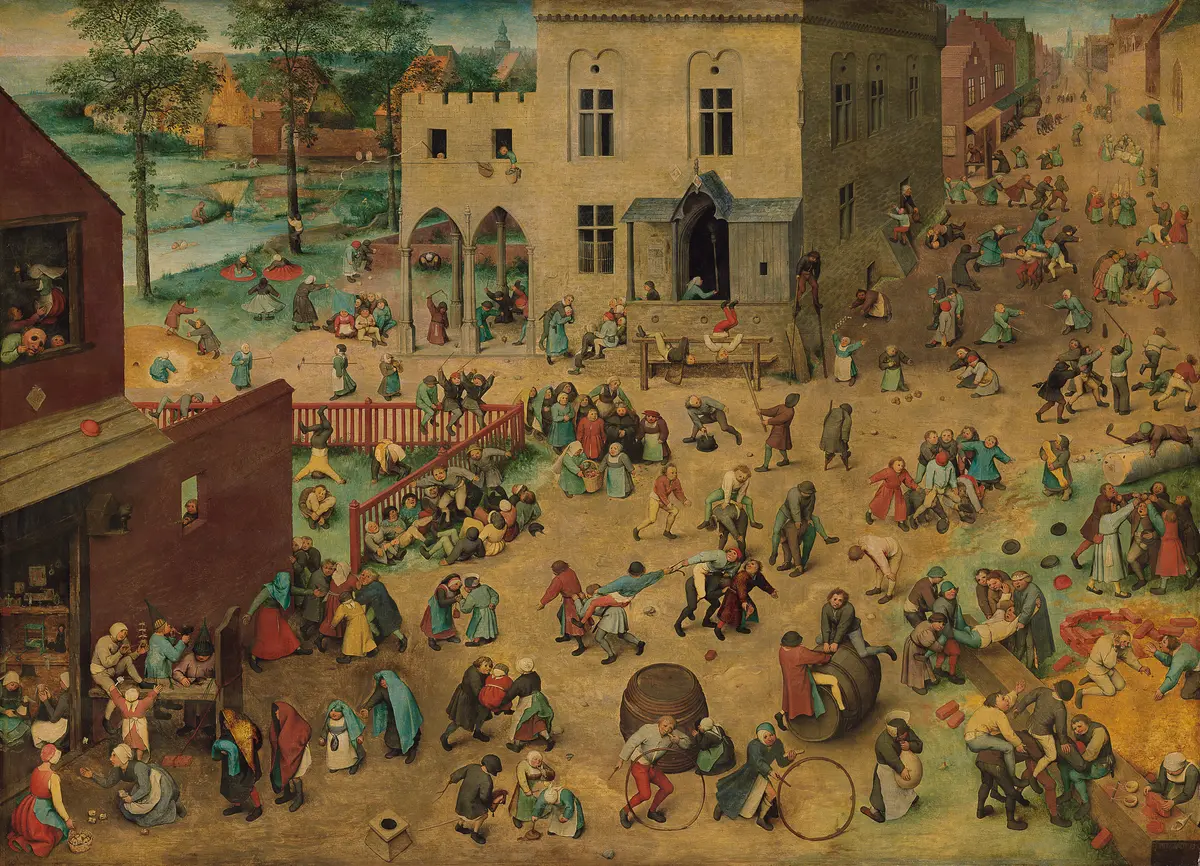
Aus der Vogelperspektive – nur so konnte Bruegel die beeindruckende Menge an Figuren lesbar unterbringen – blickt man auf einen weiten Platz. Über 230 Kinder sind mit 83 verschiedenen Spielen beschäftigt. Die Winzigkeit der Szenen zwingt, will man alle Spiele entziffern, zu einem langsamen und selektiven Studium – ein vergnüglicher Zeitvertreib. Bruegels Komposition hat in der bildenden Kunst weder Vorbild noch Parallele und ist wohl als gemaltes „Lexikon“ zu verstehen – ohne moralisierenden Unterton.
Title:
Children’s Games
Artist:
Pieter Bruegel d. Ä. (um 1525/30 Breugel oder Antwerpen? - 1569 Brüssel)
Time:
1560
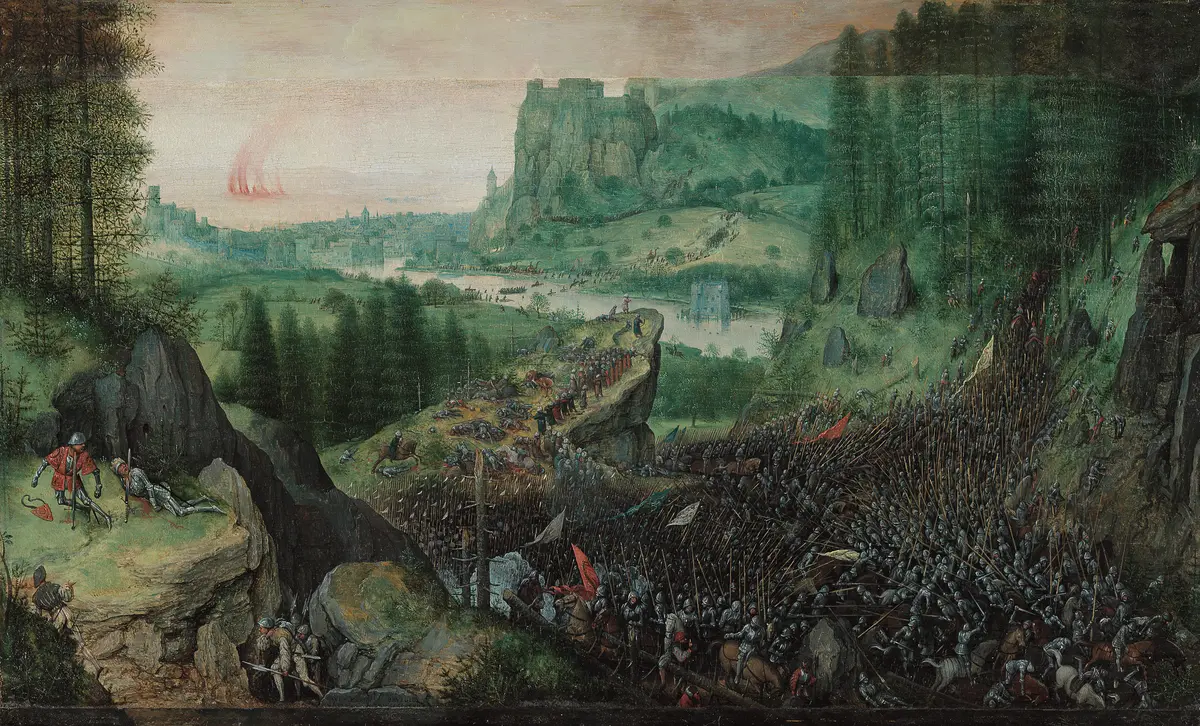
Die biblische Geschichte schildert die Schlacht zwischen Israeliten und Philistern auf dem Berg Gilboa, die mit Niederlage und Selbstmord König Sauls endet (links im Bild). Hierzu gibt es unzählige Deutungen: Bestrafter Hochmut, Torheit und Verkehrtheit der Welt, menschliche Verblendung, Vanitas; Hauptthema sei die Landschaft, die Geschichte entbehrlich; die Menschheit sei dem unaufhaltsamen Gang der Natur unterworfen.
Title:
Suicide of Saul
Artist:
Pieter Bruegel d. Ä. (um 1525/30 Breugel oder Antwerpen? - 1569 Brüssel)
Time:
1562
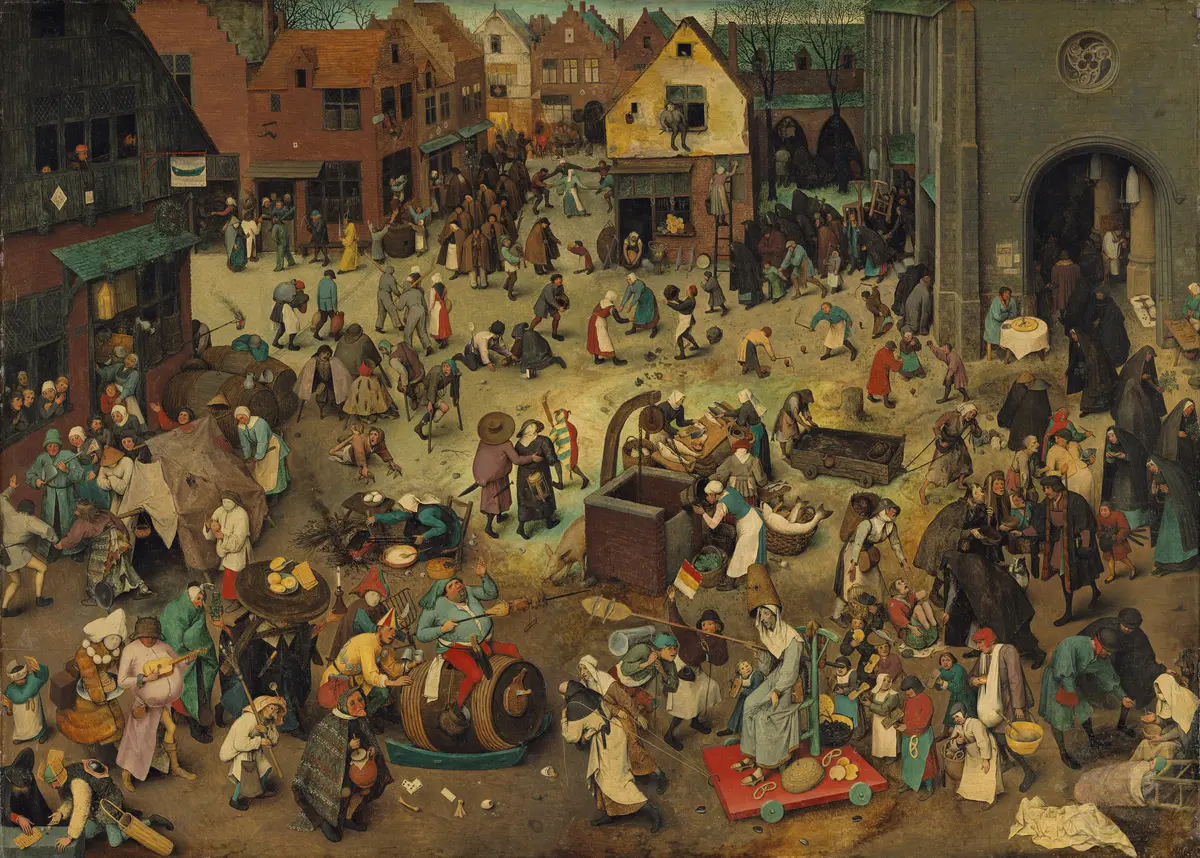
Wie während eines Turniers treten im Vordergrund die beiden allegorischen Hauptfiguren gegeneinander an: links reitet der feiste Karneval auf einem Fass und führt einen Bratspieß als Waffe. Rechts rollt die magere Fastenzeit, zwei Fische ins Treffen führend, heran. So ist man in Fastnachtspielen und Faschingsumzügen des 15. u. 16. Jhs. tatsächlich aufgetreten. Alle szenischen Details entsprechen damaliger Wirklichkeit und sind volkskundlich identifiziert. Erfunden dagegen ist die räumlich-zeitliche Gleichzeitigkeit des Geschehens.
Title:
The Fight between Carnival and Lent
Artist:
Pieter Bruegel d. Ä. (um 1525/30 Breugel oder Antwerpen? - 1569 Brüssel)
Time:
1559